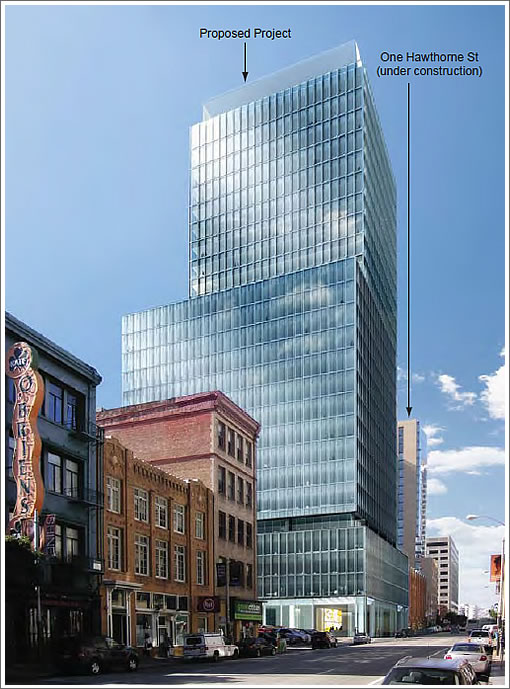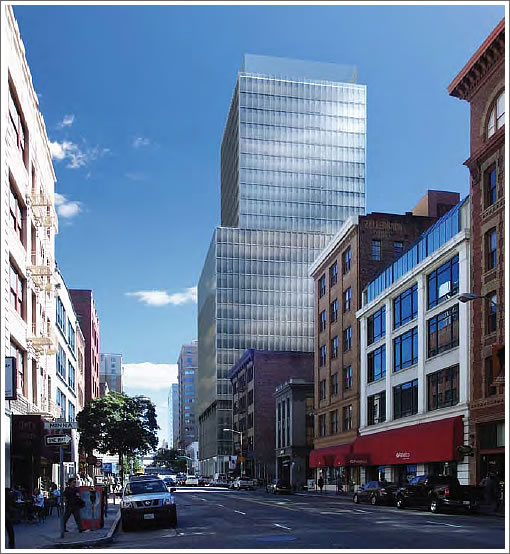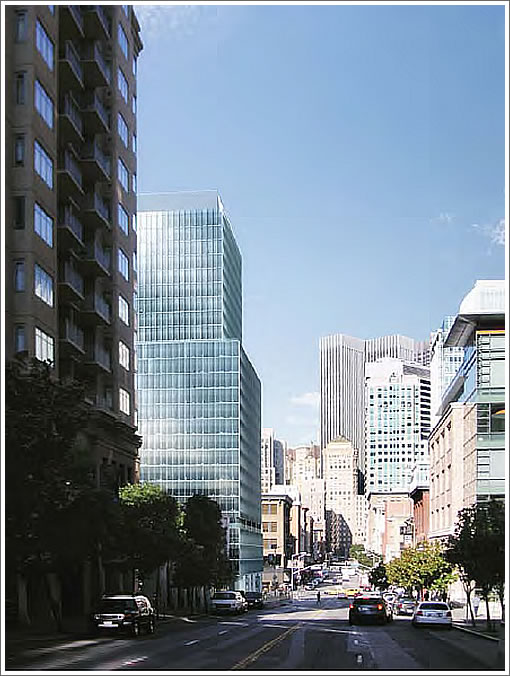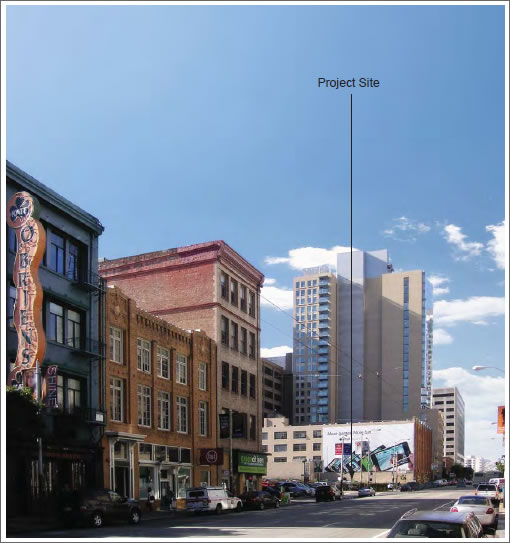
While truly plugged-in people have known about the proposed development of 222 Second Street on the corner of Howard for well over two years, details for the proposed 26-story development are now online via a Draft Environmental Impact Report (EIR).
The project sponsor, TS 222 Second Street, L.P., proposes to construct a 26-story, approximately 350-foot-tall office tower containing approximately 430,650 square feet of office space. The project would also include [4,600 square feet of] retail space and an enclosed [8,750 square foot] publicly accessible open space at the ground floor, and two levels of sub-grade parking containing 54 parking spaces.

As proposed, the project would be a rectilinear tower of diminishing bulk from the building base to a height of approximately 350 feet. At the fifth floor, the north façade of the building would be set back 5 feet from Howard Street and the west façade would be set back approximately 20 feet from the westerly property line. At the 17th story, the east façade would be set back 24.5 feet from Second Street, and the South façade would be set back 44.5 feet from Tehama Street. In addition, the fifth floor would include a further 5-foot recess, or “reveal,” on all four facades, intended to emphasize a visual break above the first four stories of the building—at a height of about 60 feet—and thereby establish a sense of continuity with nearby historic structures.

The site is currently occupied by a surface parking lot. As part of the project, the sponsor proposes to acquire and incorporate into the project site a 1,650-square-foot (20-foot–by–82.5-foot) portion of the adjacent property, which would increase the size of the project site to 25,575 square feet, and to demolish the existing loading dock at 631 Howard Street, which occupies the portion of the adjacent parcel to be acquired. The existing building at 631 Howard Street would remain.

Two basement parking levels would be provided beneath the project site, with access provided via a two way driveway from Tehama Street for a total of 54 marked parking spaces, with capacity for approximately 80 vehicles with valet parking. The basement would also include approximately 46 bicycle parking spaces, which would exceed the 12 spaces required by the Planning Code. Three additional service van spaces would also be provided in the basement.
Construction is estimated at 21 months with occupancy as early as 2013. The project architect is Heller Manus in association with Thomas Phifer and Partners.
And yes, the “TS” in “TS 222 Second Street, L.P.” stands for Tishman Speyer.
∙ The Things You Can See From Those Virtual Views (222 2nd Street) [SocketSite]
∙ 222 Second Street Draft Environmental Impact Report (EIR) [sf-planning.org]
This site has a long and distinguished history of not happening….there was an office building proposed there during the first rounds of the “beauty contest”. When was that, early 90’s? Was a victim of that recession, and has been vacant ever since. Now finally resucitated in time for the Great Recession…
How can Tishman Speyer be developing anything? Didn’t they just announce this week that they’re defaulting on Stuyvesant Town?
wonder what impact it would have on condo sales at one hawthorne given the bay facing units would look into an office building instead.
It looks like 555 Mission’s shorter and chubbier brother.
Apparently, 555 Mission is fully leased and there is a waiting list of prospective long-term tenants. Due to their long and successful relationship with Tishman,Calpers is providing 100% financing for 222 2nd St
“How can Tishman Speyer be developing anything? Didn’t they just announce this week that they’re defaulting on Stuyvesant Town”
That’s a scandalous thing to say. Tishman are the “deep pocket” guys that were going to “protect” Infinity Tower I buyers … and make Tower II the more expensive tower. How did that one work out?
Seriously though, with the number of people that TS hookwinked in the Infinity debacle, why wouldn’t they try doing it again? Seems like this is their core competency.
“How can Tishman Speyer be developing anything? Didn’t they just announce this week that they’re defaulting on Stuyvesant Town”
That’s a scandalous thing to say. Tishman are the “deep pocket” guys that were going to “protect” Infinity Tower I buyers … and make Tower II the more expensive tower. How did that one work out?
Seriously though, with the number of people that TS hookwinked in the Infinity debacle, why wouldn’t they try doing it again? Seems like this is their core competency.
Seriously though, with the number of people that TS hookwinked in the Infinity debacle, why wouldn’t they try doing it again? Seems like this is their core competency.
You mean sold units at the price the market would bear at the time? Sounds like capitalism to me.
I realize none of the smarty pants on this site can resist pointing out how stupid everyone (but themselves) are, but markets are markets. Sometimes you win, some times you lose.
“You mean sold units at the price the market would bear at the time? Sounds like capitalism to me.”
True, unless you provide express or implied assurances that you would act in the best interest of the early buyers of T1. Those that posted on this site certainly gave the impression that this was the case. In that case one could argue that the conduct amounts to fraud.
Blaming TS for the down market is ridiculous, I think they would like to sell their units for as much as possible, just like any other owner.
Having closed 40+ deals at the Infinity, including 3 of the lowest price per square foot units there, I can tell you from experience, that no one is coming down on price without a fight. I am sure if they could have maintened sales absorption without discounting, they would have. My experience with TS is that they are an honorable company, with honorable business men in charge. Sometimes you have to make business decisions. Maybe they needed cash, because they were bleeding someplace else. I don’t know.
The determination of value is only good at that exact moment in time. Real Estate is a spot market.
For example, I am telling you there are a lot of buyers out there right now. A lot. The psychology of the buyer is to get a deal right now, but there are a lot of them out there right now. It’s heating up. Inventory of good stuff is not that great in SoMa / South Beach.
And yes, there are good deals out there. They are getting multiple offers and they are getting taken quickly.
Save your “evil realtor” flames, if you can’t handle the truth then don’t read my posts.
“Due to their long and successful relationship with Tishman,Calpers is providing 100% financing for 222 2nd St”
A keiretsu is a group of enterprises with interlocking business relationships and shareholdings.
555 Mission is 50% leased and there is no ‘waiting list’ for long term tenants. That’s pretty funny though,,,
“Due to their long and successful relationship with Tishman,Calpers is providing 100% financing for 222 2nd St”
Yes, like the $500 million Calpers lost in Stuyvesant Town thanks to Tishman? That’s a wonderfully successful relationship.
hugh wrote:
So what if they did? As I’m sure you’re aware if you’ve been following along, Tishman Speyer used very little of their own money for the Stuyvesant Town project, and pledged no other of their buildings as collateral. Basically classical postmodern capitalism; Robert T. Kiyosaki would be proud.
“The determination of value is only good at that exact moment in time. Real Estate is a spot market.”
You’ve got to be kidding Paul. If so then by extension comps are meaningless, as are the other industry stats.
Yeah, the market does vary over time and many properties require individual analysis. But this spot market, all micro stuff is just a cop out to get the buyer/seller to act more on impulse and less on analysis.
Milkshake,
Not kidding. Everything is case by case.
Paul
“Yeah, the market does vary over time and many properties require individual analysis. But this spot market, all micro stuff is just a cop out to get the buyer/seller to act more on impulse and less on analysis.”
Would have to agree with Milkshake here. This is all about marketing. Certainly some properties require individual analysis, but you’d have some people on SS telling you that it’s a whole new housing market because a house is listed on Thursday instead of Tuesday or because the pictures show a sunny day instead of a rainy day.
Also, analytically, it just doesn’t work to say that comps only apply on the way up. 🙂
“Basically classical postmodern capitalism”
It must be… because it defies easy grasp. It looks like TS borrowed $3 billion (which, in turn was packaged as mortgage backed securities)… and paid $5B for a property now valued at around two.
Who takes the loss? I am perplexed at how the company can lose that much, and not be forced to liquidate.
People with no compelling reason to buy, won’t.
(It’s been well established that many Socketsite posters believe there are better less risky asset classes than real estate.)
That leaves the people who are buying, whom must have a compelling reason to do so, probably other than financial. They are going to buy no matter the advice that appears here.
Therefore, the buyers who have decided to buy would be prudent to make their decision case by case at the immediate moment of purchasing. A spot market as it were.
Even the people trying to predict the future are going to make their decisions as of this moment when purchasing.
Tishman Speyer are only into Stuyvesant Town (with their own money) for $112M. Lot of other folks losing their shirts, but not TS. Check the name link for a New York Mag. article about it.
@Scooter,
I was just reading up on that. And learning the term ‘mezzanine debt’. I suppose there’s a lot more analysis to come on this, unless it’s too complex to get any attention. It’s just amazing. The majority of the loss is going to be shouldered by Fannie/Freddie, and investors like CalPERS (and other foreign and domestic public entities)… so the short answer… the public at large pays for a huge gamble, that if successful, would have involved a seriously ethically questionable chain of events.
Obviously, the financial mess is far from over. Not sure if this comment is appropriate… but it’s amazing how much reward for so little risk a company like TS can manage… and seemingly not even be tarnished by a colossal failure…
So TS is willing to bet (probably with other people’s money) that the SF commercial RE scene will rebound in 3-4 years, just like after the tech wreck in ’02. Is planning for the next boom in the depths of the current bust such a stupid long-term strategy?
The Eeyore-like Zen of the SS doom sayers (“Things are terrible, they’ll always be terrible, woe is me, my neighbor’s house isn’t pretty and they paid too much”) has mostly entertainment value.
Obviously, the financial mess is far from over. Not sure if this comment is appropriate… but it’s amazing how much reward for so little risk a company like TS can manage… and seemingly not even be tarnished by a colossal failure…
Uh, haven’t you been reading the papers or watching TV or surfing the web for the last two years!? We had this little thing called a meltdown caused by people risking other people’s money and getting bailed out by the feds/taxpayers. AIG, BofA, Goldman Sachs, etc, etc…
^^
Is this not somehow different? For one thing, it’s happening now, and not in 2008. Other than packaging the debt as securities, it’s a little different, no? The sheer scale of it (though maybe it’s just another blip in 700+B debt portfolio of F/F), the fact that there’s nothing subprime about it… maybe it’s isolated and lagging fallout, but it seems to be getting an inordinately low amount of attention.
“It’s been well established that many Socketsite posters believe there are better less risky asset classes than real estate.”
Tell that to your condo purchasers, Paul. Spot markets are for commodities and securities, not houses. Your explanation for why housing is a spot market is a joke.
anon,
Actually if they tell me “Paul, all I want to do is make money.” that’s exactly what I tell them; “There’s probably a better asset class for you with less risk than a condo in San Francisco.”
Paul
Interesting update. TS may have to come up with some more cash. Apparently jingle mail requires additional postage in NY. I wonder how much they took out in management fees before this foundered vs their original miniscule investment.
http://www.bloomberg.com/apps/news?pid=20601109&sid=abJr.75vRxsg&pos=15
The planning commission meeting is this coming Thursday. The proposed project requires a number of code variances. The top rendering will give you a pretty good idea of how horribly out of scale and character with the immediate neighborhood the huge glass cube would be.
Any comments by all you “plugged in” folks on the EIR would be greatly appreciated.
Whether you have profited or lost in the downturn:
With few exceptions, residential real estate is transacted in a SPOT market. Futures in the form of early, NON-refundable deposits are the exception, not the norm. “Comps” are close to meaningless in this context, and have always been–except that prudent valuation analysis should include some form of comparative analysis (used liberally as more than a ‘reality check’, not as an indication of value). More relevant than “comps” would be simple CF analysis, using today’s spot rents, cost of capital/carry, etc.
Paul is again right (IMHO) and is writing as an informed multi-asset class investor, not as an agent or principal trying to support transactions. He is also right in suggesting that there are numerous alternatives to real estate–that have consistently offered superior risk-adjusted returns.
To wit, thousands of unfathomable fortunes ($1B+) have been made or lost in RE with far less capital, offering many multiples of beta vis a vis lower risk adjusted equities. Why? The volatility is, of course, due to the conventions of debt-financing, vagaries of severely illiquid markets, and the unique nature of virtually immovable, restricted-use assets. All this is already known and understood.
What has changed: The recent real estate bubble (created, of course, by a decade of global growth/vibrant economy and increasingly favorable tax treatment–rewarding flipping, etc.) is NOT representative of the longer-term investment potential of real estate (hence: “bubble” and supporting the assertive that ‘comps’ don’t matter). Given the administration’s recent shift in ideology, an army of scorned investors and trillions in capital loss–wee should now expect a slow reversion to mean and a return to more ‘normal’ historical returns.
What’s that you say? Investors should (again) value real estate for its utility value (home sweet condo) and tax benefits, far and above any longer-term appreciation potential. These benefits alone are substantial and compelling, which leaves future appreciation as a mere frosting that should never be predicted or expected on a short-term basis (less than 3-years).
Both T1 and T2 will do fine (IMHO) and Paul, you have again reminded me why we are fortunate to have your expertise in this market and I look forward to becoming a client (no, I am not and am not affiliated in any way).